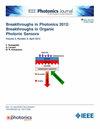120 GHz Sub-2 V Thin-Film Lithium Niobate Modulators on Silicon Substrate Using Thick Capacitively Loaded Slow Wave Electrodes
IF 2.1
4区 工程技术
Q3 ENGINEERING, ELECTRICAL & ELECTRONIC
引用次数: 0
Abstract
Electro-optic modulators with large bandwidth and low voltage are crucial for the high-baud-rate digital communication and high-carrier-frequency analog links. Recently, thin-film lithium niobate (TFLN) modulators with sub-1 V voltage and 140 GHz bandwidth have been emerged on the low permittivity substrates, such as quartz. However, on the high permittivity environment, such as silicon substrates, the bandwidth dramatically reduced to below 100 GHz even if the voltage was raised to around 3 V. We break the voltage–bandwidth trade-off limit in TFLN modulators on silicon substrates using low inductance thick metal traveling wave electrodes, which reduce RF phase index and microwave losses while preserving high EO modulation efficiency. We demonstrate a TFLN EO modulator on silicon substrate with 3 dB EO bandwidth使用厚电容加载慢波电极的硅基底 120 GHz 2 V 以下铌酸锂薄膜调制器
具有大带宽和低电压的电光调制器对于高波特率数字通信和高载波频率模拟链路至关重要。最近,在石英等低介电常数基底上出现了电压低于 1 V、带宽为 140 GHz 的铌酸锂薄膜(TFLN)调制器。我们利用低电感厚金属行波电极打破了硅基板上 TFLN 调制器的电压-带宽权衡限制,在保持高 EO 调制效率的同时降低了射频相位指数和微波损耗。我们在硅衬底上展示了一种 TFLN EO 调制器,其 3 dB EO 带宽为 $>$ 120 GHz,半波电压为 $(V_\pi) < $ 2 V,带宽/$V_\pi$达到 60,明显大于传统的 TFLN 调制器。所提出的铌酸锂薄膜调制器为硅和铌酸锂的混合集成提供了一种实用的解决方案。
本文章由计算机程序翻译,如有差异,请以英文原文为准。
求助全文
约1分钟内获得全文
求助全文
来源期刊

IEEE Photonics Journal
ENGINEERING, ELECTRICAL & ELECTRONIC-OPTICS
CiteScore
4.50
自引率
8.30%
发文量
489
审稿时长
1.4 months
期刊介绍:
Breakthroughs in the generation of light and in its control and utilization have given rise to the field of Photonics, a rapidly expanding area of science and technology with major technological and economic impact. Photonics integrates quantum electronics and optics to accelerate progress in the generation of novel photon sources and in their utilization in emerging applications at the micro and nano scales spanning from the far-infrared/THz to the x-ray region of the electromagnetic spectrum. IEEE Photonics Journal is an online-only journal dedicated to the rapid disclosure of top-quality peer-reviewed research at the forefront of all areas of photonics. Contributions addressing issues ranging from fundamental understanding to emerging technologies and applications are within the scope of the Journal. The Journal includes topics in: Photon sources from far infrared to X-rays, Photonics materials and engineered photonic structures, Integrated optics and optoelectronic, Ultrafast, attosecond, high field and short wavelength photonics, Biophotonics, including DNA photonics, Nanophotonics, Magnetophotonics, Fundamentals of light propagation and interaction; nonlinear effects, Optical data storage, Fiber optics and optical communications devices, systems, and technologies, Micro Opto Electro Mechanical Systems (MOEMS), Microwave photonics, Optical Sensors.
 求助内容:
求助内容: 应助结果提醒方式:
应助结果提醒方式:


